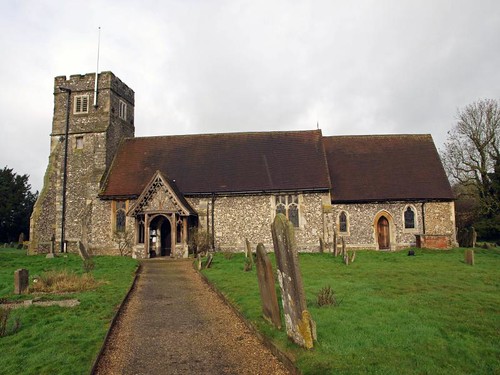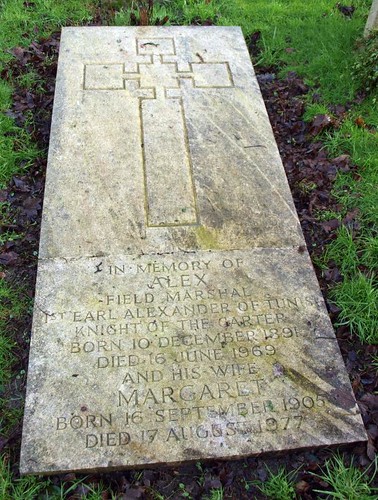This is a shame as the location, even in the returning rain, is stunning, it's an attractive building and I'd like to see the St Christopher; plus the alabaster monument to Lady Busby, d.1661, with a bayleaf band around an inscribed slab, empty cartouche at head, skull at base, fruit and ribbon ornament, early C18 floor slabs and an indent for a brass in chancel and nave floors, early C19 slabs on chancel N wall, tapestry Royal Arms of George III mounted on N wall of nave with plank dated 1814 and fragments of c.1390 glass in upper panels of E window in nave N wall which are all inaccessible.
Besides which any church that has a "lively king-post roof" should be kept open by default.
ST MARGARET. Nicely placed N of a village Green with some weatherboarded barns and a half-timbered cottage. The church belongs to the C15. It is of flint with stone dressings and has a low battlemented W tower with big diagonal buttresses, a tiled nave and lower chancel, and a very pretty C19 timber porch with bargeboarding and traceried openings on the sides (A. Billing, 1881). Aisleless interior with two-light straightheaded windows and a good, lively king-post roof. - Large WALL PAINTING of St Christopher, mid C15, very raw. - PLATE. Chalice and Salver, 1740; plated Flagon, also C18.
Ridge. True to its name, it stands on a wooded ridge with a view stretching to distant Barnet. Its narrow church was made new by 15th century builders who left only the piscina to show that there was a church here 700 years ago. Much has been altered since, but there are fragments of 15th-century glass in a window, fragments of a painted St Christopher on a wall, and fragments of three medieval sun clocks cut in stone on the outside. In the tower (less than nine feet square) hang two bells from Stuart England.
Those were the days when Sir Henry Pope Blount, whose memorial is on the wall, lived at Tittenhanger Park, the fine Stuart house he built near London Colney on the site of a house where Wolsey and the king took refuge from the plague. Sir Henry was born at Tittenhanger in 1602, and at 32 he made the famous journey described in his Voyage to the Levant, a book which ran into eight editions while the Stuart throne was lost and won again. This journey took him through the Balkans to Constantinople, with the Turkish fleet to Egypt, through the dark passages of the Great Pyramid at Gizeh, and home by way of Florence, which he reached after travelling 6000 miles in 11 months. He died here at 80 and was buried in the church, and his son Thomas proceeded to make the family name still better known by publishing a vast compendium of what 600 great writers of all ages had written about each other. Thomas, who lies here with his father, was a scholar who believed heartily that scholars were not of much use to the State. It is clear that Thomas must have been a man of great modesty, for he himself was of wide learning, and in addition to the great book he produced in 1690, with the opinions of famous writers about one another, he published a natural history extracted from the best authors, and a great book of poetry surveying the poets of all time.
Those were the days when Sir Henry Pope Blount, whose memorial is on the wall, lived at Tittenhanger Park, the fine Stuart house he built near London Colney on the site of a house where Wolsey and the king took refuge from the plague. Sir Henry was born at Tittenhanger in 1602, and at 32 he made the famous journey described in his Voyage to the Levant, a book which ran into eight editions while the Stuart throne was lost and won again. This journey took him through the Balkans to Constantinople, with the Turkish fleet to Egypt, through the dark passages of the Great Pyramid at Gizeh, and home by way of Florence, which he reached after travelling 6000 miles in 11 months. He died here at 80 and was buried in the church, and his son Thomas proceeded to make the family name still better known by publishing a vast compendium of what 600 great writers of all ages had written about each other. Thomas, who lies here with his father, was a scholar who believed heartily that scholars were not of much use to the State. It is clear that Thomas must have been a man of great modesty, for he himself was of wide learning, and in addition to the great book he produced in 1690, with the opinions of famous writers about one another, he published a natural history extracted from the best authors, and a great book of poetry surveying the poets of all time.


No comments:
Post a Comment